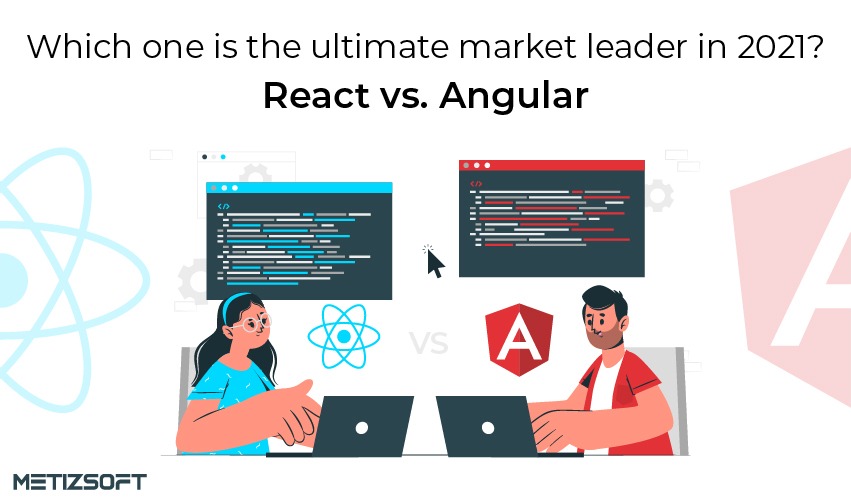
There are several front-end web development frameworks available in the market. Whenever someone plans to build an online app or website, they do their market research. They go through all the options and then decide the one which suits their business needs the most. This is an essential step in choosing the proper framework for developing a website or app that works for them the best.
Out of all the Javascript libraries and frameworks, two of the most successful and popular ones are- React vs. Angular. These two frameworks are in tough competition, and business owners often get confused between these two frameworks because of their increasing demand.
We will take you through a detailed React vs. Angular comparison so that you can choose the right front-end development framework for your next project.
Before we begin with the comparison, let us briefly know these two platforms.
Table of Contents
What is React?
React is an open-source JavaScript library supported by Facebook. It has become quite popular in web app development because of its features and functionality.
React has gained immense and widespread popularity in the past few years and has become an ideal choice for someone who is just getting started with JavaScript frameworks and start-ups.
The framework provides excellent support and flexibility to integrate with other frameworks to mix and match to create a customized app solution.
Here are the pros of React-
- Easy to learn
- Supports server-side rendering
- Easier to migrate between different versions
- Uses javascript rather than other framework-specific code
- Modular and cohesive components
Here are the cons of React-
- Poor documentation
- JavaScript might become a barrier for new developers
What is Angular?
Angular is a web app development framework developed and maintained by Google, released under the name AngularJS back in 2010. It became one of the most popular web app development frameworks over the years due to its two-way data binding and dependency injection features.
The web app framework is one of the most mature and widely used frameworks with great support and an extensive team of contributors. Angular is considered a full-stack package solution. It has established itself in the market and remains at the top of its game.
Here are the pros of Angular-
- It follows clean code development
- It is a high-performing all-in-one platform
- It has a material design like an interface
- Angular offers seamless updates using CLI
Here are the cons of Angular-
- Angular can be confusing for beginners
- Angular is a full-stack solution, and therefore, third party integrations can be complicated
- Switching between the versions is troublesome in Angular
- It lacks all-inclusive documentation
Now, as we know these two frameworks, in brief, we will focus on React Vs. Angular- the Javascript framework comparison and see what the significant differences between these two frameworks are.
The detailed comparison- React vs. Angular
- Learning Curve
Angular is a full-stack platform, so if you want to create a project on Angular, you need to learn a lot of things like Typescript-in-depth, MVC, and so many other concepts which are necessary for developing an app on Angular such as directives, modules, components, services, dependency injections, and templates.
Angular has strict coding, which means the developers must know coding to create an app with Angular. This might become a hurdle for the new developers.
Overall, there are many things to learn before beginning with Angular, making it a complex platform to begin with.
React is a library, so it has fewer learning concepts than Angular. This feature of React makes it a preferred choice for new developers. React uses JSX, which is a way of writing HTML into JavaScript.
React also provides more flexibility and many other options to the developers, making app development easier.
Result- After analyzing both the frameworks, we can say that as compared to Angular, React is easier to learn.
- Component Architecture
The component architecture is an approach to building the architecture of a web app based on replaceable components. The component architecture helps to manage complexity and encourages code reusability.
React approaches UI with the philosophy of breaking it down into components. These components manage their state and structure them together to create complex UI solutions. However, you will need other integrations with react since it’s a Javascript framework.
Here are some of the supporting tools of React-
- Redux
- web pack
- Babel
Angular, on the other hand, is a full-stack framework and comes with many unique and out-of-the-box possibilities and offerings such as-
- RxJS
- Angular CLI
- Angular universal
Result- Both React and Angular have unique component architecture, but Angular doesn’t require additional integrations and provides an excellent comprehensive web development solution.
- Performance
The performance matters the most when it comes to any framework or platform. The success of your website or web app depends on how well it performs.
When it comes to React’s performance, it has several features such as virtual DOM trees, built on the server, which are very lightweight. Due to its lightweight, loading time gets reduced.
Furthermore, the data binding process of React is unidirectional, which ultimately reduces the workload time.
Angular, on the other side, has a bidirectional data binding process; therefore, each binding requires a watcher to track the modifications. Thus, the bidirectional data binding might impact Angular’s performance negatively.
Result- When it comes to the performance of these frameworks, React seems to have the edge over Angular.
- Ease of Updates
As we know, all the Javascript frameworks and other platforms go under various updates all the time. To remain updated is essential for any framework to work well. Updates are an essential aspect of any app or website, and if you stay updated, you can create the best solutions in the market.
React’s front-end library is dependent on external libraries, which makes migrating and updating the third-party components possible.
The React developers also need to check if all the third-party libraries are compatible with the latest version of the Javascript framework.
Angular has several commands like ng update, which is quite helpful for any Angular app to upgrade to the latest version easily. As the update process is automated, it reduces the stress of Angular developers.
Result- When it comes to the updates, Angular is easier to update than React.
- UI Components
React community develops various UI tools out of which some are free, and some are paid. When using React, installing an additional library-Material- UI library and dependencies to use the material design components is necessary.
On the other hand, Angular is a complete solution and has an in-built material toolset and various pre-built material design components to use.
Angular’s material design components have multiple layouts, pop-ups, and so on. These UI components make the UI configuration simpler.
Result- When it comes to UI components, Angular has the edge over React because the UI configuration is easier with Angular’s pre-built material design components.
- Dependency Injections
Dependency injections are the tools that help in solving a common development problem- hardcoded dependencies. The dependency injection solves this problem and increases a code’s modularity.
React doesn’t use any dependency injection because it has an in-built dependency injection system in JSX. This enables React to offer a dependency injection without having a container for the same. React also allows adding more than one dependency to an element.
Angular’s dependency injection is based on injectors, providers, and tokens. All the Angular modules come up with an injector associated with them.
These dependencies are then added to these injectors by leveraging the provider’s property of the module’s metadata.
Result- When it comes to dependency injections in React vs. Angular comparison, both of these frameworks support dependency injections in their own way.
React vs. Angular, which one to choose?
Mentioned above were the main points of differences between React vs. Angular JavaScript framework comparison. After reading the factors above, you might be confused about which one to choose for your next project.
We have to tell you that there is no perfect framework or library. The framework you select depends upon your project needs and requirements. Every web development framework has some pros and cons, and the same is with React and Angular.
Looking at the factors above, we can only say that if you are a beginner and are looking for a framework that requires less coding and is easy to use, you can go for React. React’s learning curve is easier than Angular, which makes it a preferred framework for beginners.
On the other hand, if you want a full-blown framework to build an app, Angular is the right choice.
The final choice lies in your hands, we could only guide you.
If you want to know more about JavaScript framework comparison, you can reach out to Metizsoft. Their team will help you make a decision and also help you develop the most powerful and functional apps with these frameworks. Get in touch today.
AboutChetan Sheladiya
Related Posts
Why Migrate from AngularJS to Angular? How will it help you?
Do you want to migrate from AngularJS to Angular? We will take you through the benefits of migrating to AngularJS to help you...
5 Big Reasons to Choose React Native Framework for Your Next Mobile Application Project!
The world of technology is growing through an exciting phase. New technologies are emerging, and so are the terminologies...

